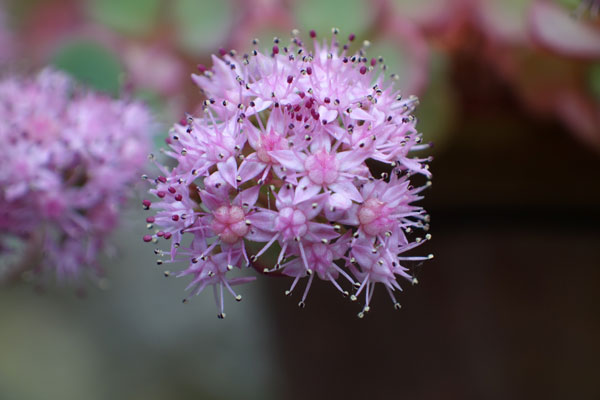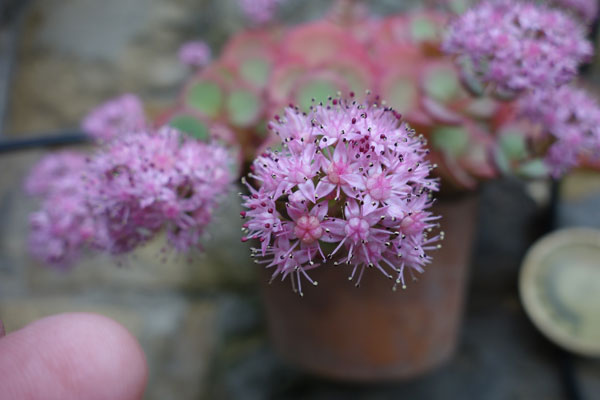Sony RX100 M1: Close-Up Experiences - Hand-held Close-up Lenses
This page and its companion pages discuss the macro, or better, close-up, abilities of the Sony RX100 M1. Although the camera has a macro mode (allowing shots from 5 cm), I would not call these photos "macros" and therefore use the term "close-up."
On this page, I present some experiments with hand-held close-up lenses, a Marumi +5 achromat, and a Dörr +10 achromat. See also page Close-Up Experiences - MagFilter Adaper Tests for more reliable results (because the close-up lenses are there firmly attached to the lens).
Introduction
Since the lenses of the Sony RX100 models do not have a filter thread, I cannot use my existing close-up lenses with this camera. At least, I would have to buy some sort of "lens adapter" like the one that Sony sells (VFA-49R1). In his book on the Sony RX100 M1, Alexander S. White mentions the Lensmate adapter for the Sony RX100 (all models) as an alternative. This adapter has, however, to be imported from the U.S.A. It costs about 25 $ as a kit (plus customs for Germany). I ordered this adapter at the beginning of October 2017 for my RX100 M4, received it on October 20 after it was checked by the German customs, and report my experiences here (unboxing and installation) and here (first experiences with my close-up lenses).
But before I ordered and received the Lensmate adapter for the RX100 M4, I remembered what I did as a youth: I was allowed to use my father's Braun Paxette Reflex SLR, which had a fixed 50 mm lens, and I took quite a few close-up shots with bare lenses that I simply held to the camera lens with my hand. My father gave me these lenses, and as far as I remember, they were taken from the lens of an old slide projector. All in all, this worked quite well for me. So I concluded that, using the "hand-held" method, I would at least be able to get an impression of which magnifications I would get with different close-up lenses, of the overall quality of the close-up shots (with a grain of salt, because it is very fiddly to hold the camera and the close-up lens...), and of a few things more. Therefore, I did a first experiment with two of my close-up lenses, a +5 Marumi achromat, and a +10 Dörr achromat, the results of which I report on this page.
But what about my wife's RX100 M1? I talked with my wife about adapters for close-up lenses, and she seemed quite interested in these, but wanted to wait for my experiences with such an adapter on my M4. Nevertheless, I decided that I could, as a start, do the same kind of experiment that I did with my M4, namely hold my close-up lenses to the lens of her camera and check the results.
A First Experiment
When I measured the minimum object width for different zoom lengths, I found out that only two zoom lengths are interesting for close-up shots, namely 28 mm and 100 mm (both equiv.). The latter provides a larger minimum object width (about 20 cm), but also a large object distance of 55 cm. A focal length of 28 mm (equiv.) might also be usable, but for my experiment I restricted myself to the conditions shown below (see test shots below) - and got the following results:
- 28 mm (equiv.): approx. 80 mm (object height is 53 mm at for a 3:2 image format; the object distance is 5 cm)
- 28 mm (equiv.) with Marumi +5 achromat: about 67 mm (object height is 45 mm for a 3:2 image format; the object distance is lower but was not measured)
- 28 mm (equiv.) with Dörr +10 achromat: about 55 mm (object height is 37 mm for a 3:2 image format; the object distance is lower but was not measured)
- 28 mm (equiv.) with two Marumi +10 achromats (+10): about 53 mm (object height is 35 mm for a 3:2 image format; the object distance is lower but was not measured)
- 100 mm: approx. 200...205 mm (object height is 133 mm for a 3:2 image format; the object distance is 55 cm)
- 100 mm (equiv.) with Marumi +5 achromat: about 62 mm (object height is 41 mm for a 3:2 image format; the object distance is lower but was not measured)
- 100 mm (equiv.) with Dörr +10 achromat: about 37 mm (object height is 25 mm for a 3:2 image format; the object distance is lower but was not measured)
- 100 mm (equiv.) with two Marumi +5 achromats: about 36 mm (object height is 24 mm for a 3:2 image format; the object distance is lower but was not measured)
The following table summarizes my minimum object width results for the Sony RX100 M1 and M4:
Sony RX100 M1 |
Sony RX100 M4 |
||||||||
Focal Length |
Close-up Lenses Setup |
Focal Length |
|||||||
| None | M +5 | 2 x M +5 | D +10 | None | M +5 | 2 x M +5 | D +10 | ||
| 28 | 80 mm | 67 mm | 53 mm | 55 mm | 100 mm | n.a. | n.a. | n.a. | 24 |
| 100 | 200-205 mm | 62 mm | 36 mm | 37 mm | 161-162 mm | 68 mm | 46? mm | 46 mm | 70 |
Summary
That is, at the telephoto end you get a minimum objects width of much more than a postcard without a close-up lens, with a Marumi +5 achromat it is about 7 cm, and with a Dörr +10 achromat it is even below 5 cm. That means that with any of these achromats you get a smaller minimum object width than with a focal length of 28 mm (equiv.) without a close-up lens. (At 28 mm (equiv.), a close-up lens would lead to fairly short distances, which makes this set-up less usable.)
Test Shots
The following informal photos measure the minimum object width (using manual focus) at the wide end of the zoom range using a ruler:
 |
 |
|
No close-up lens: about 80 mm |
Marumi +5 achromat: about 67 mm |
|
 |
 |
|
Dörr +10 achromat: 55...56 mm |
Two Marumi +5 achromats (+10): 53 mm |
Photos: Horizontal section of test photos at 28 mm (equiv.)
The results varied a lot because of the experimental settings and thus, should not be taken too seriously...
The following informal photos measure the minimum object width (using manual focus) at the telephoto end of the zoom range using a ruler:
 |
 |
|
No close-up lens: about 200 mm |
Marumi +5 achromat: about 62 mm |
|
 |
 |
|
Dörr +10 achromat: 37 mm |
Two Marumi +5 achromats (+10): 36 mm |
Photos: Horizontal section of test photos at 100 mm (equiv.)
All in all, there is some pincushion distortion visible, but probably this will not be a problem with "nature shots". Moreover, the distortions seem to be stronger at the wide end, where close-up lenses make less sense. At the tele end, however, a +5 or +10 close-up lens brings more magnification than no close-up lens at the wide end, combined with a larger object distance. Interestingly, magnification is higher at the tele end than at the wide end for any close-up lens or combinations that I tested.
The Achromats
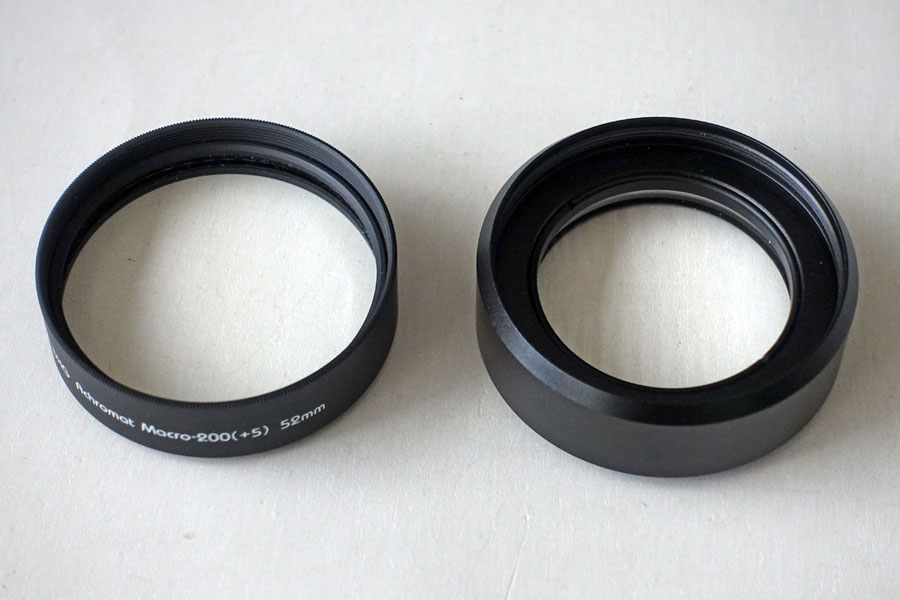 |
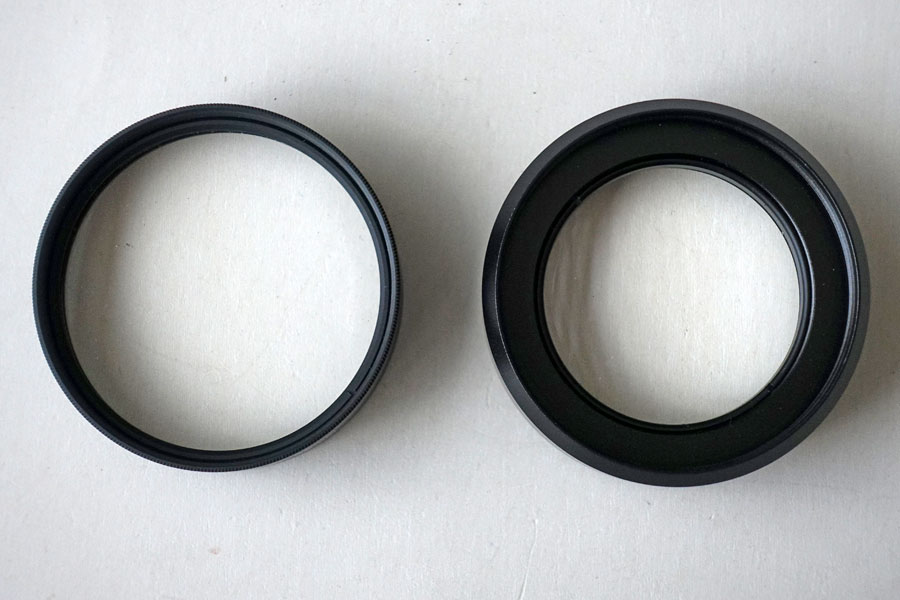 |
|
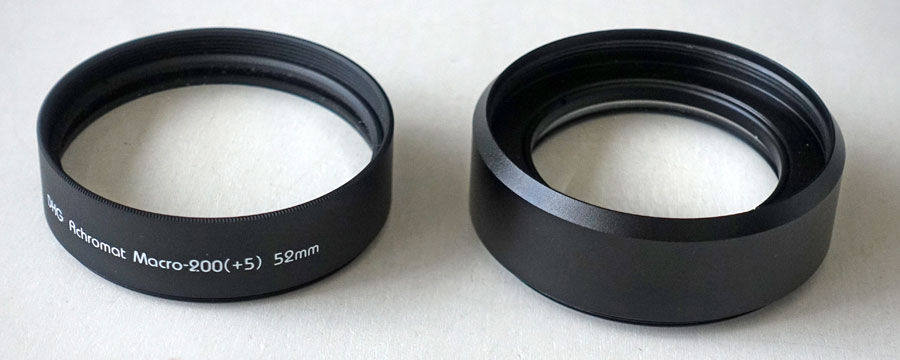 |
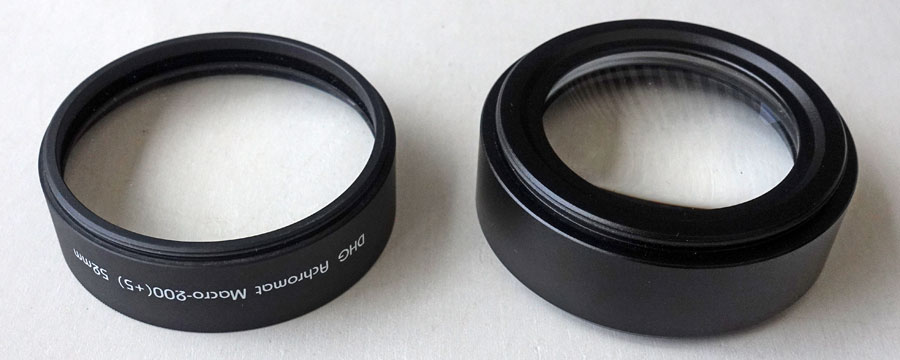 |
Photos: Marumi +5 achromat (left) and Dörr +10 achromat
Please note that the Dörr achromat is part of the Dörr slide copier and not available on its own. Since I own two Marumi +5 achromats, I can stack both to get the same effect as with the Dörr achromat.
Sample Photos
The following photos demonstrate quite well, that close-up lenses work better for the Sony RX100 M1 at the telephoto end. Here +5 and +10 diopters close-up lenses or lens combinations lead to significantly increasing magnifications even beyond the camera's maximum magnification at the wide end - although the magnification without a close-up lens is poor at the telephoto end..
Conclusions
Using close-up lenses at the Sony RX100 M1 makes sense only when these are used at the telephoto end. The magnification increases consistently with increasing diopter numbers, larger magnifications are achieved, and the shooting distance is wider and thus, leads to a better perspective and disturbs insects less. You also cast less shade on the objects that you take photos of.
References
- Alexander S. White (2012). Photographer’s Guide to the Sony DSC-RX100. White Knight Press, Henrico, Virginia (ISBN: 978-1-937986-08-7, paperback)
- Post on RX100 Macros: 09-11-2012 05:42 PM - community.sony.com/t5/Cybershot-Cameras/RX-100-Macro/td-p/28896
- SONY RX100 V Quick Change Adapter Kit 52mm by Lensmate: lensmateonline.com/products/lensmate-rx100-iii-rx100-ii-rx100-quick-change-adapter-kit-52mm?variant=998641683
- VFA-49R1 49 mm Filter Adapter: www.sony.com/electronics/cyber-shot-compact-cameras-other-accessories/vfa-49r1
| 03.04.2018 |

